The Best Steelhead Flies Used By Top Guides
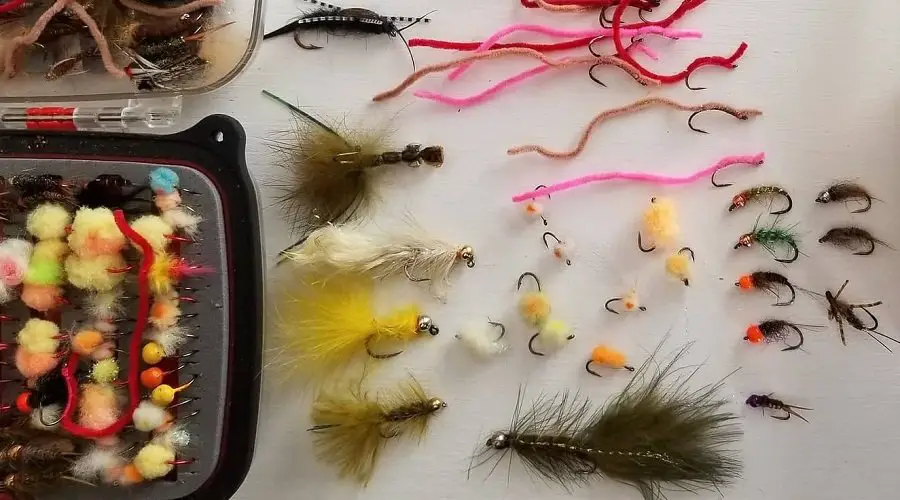
There are hundreds of good fly patterns for steelhead, but the best ones are the tested and proven fly patterns found inside the fly boxes of experienced fishing guides.
I’ve been a steelhead guide for over 20 years, and I have networked and shared fly patterns with many other guides, as well as lodges and local fly shops, which is why I know what steelhead flies are hot.
The best flies for steelhead are the ones that consistently work day after day in almost any river where steelhead exist.
Top 5 Quick Pick
- Egg Patterns: Best used when salmon or steelhead are spawning, but egg patterns can be good all the time. There are many variations, which I’ll discuss below.
- Stonefly / Mayfly Nymphs: Nymphs like stoneflies and mayflies are great when the steelhead are not gorging on eggs. For summer-run steelhead before the salmon spawn, nymphs are the most productive flies. Late spring is another time when steelhead love nymphs. The Easy Stonefly and Hare’s Ear are two of the best.
- Worm Flies: Worm patterns are one of my best steelhead fly patterns, and at certain times of the year, a pink or red worm will work better than all other flies.
- Woolly Buggers: Micro Buggers and full-size Woolly Buggers are great for steelhead fishing. They come in many sizes, colors, and a few great variations.
- Hoh Bo Spey: An easy-to-tie but very effective fly for spey fishing and for swinging flies.
- Steelhead Streamers: Streamer flies like the Zonker that imitates sculpins, minnows, and other baitfish can be great for steelhead.
If you are not using the same flies the guides are using, you’re missing fish!!
We may make a small commission from some of the links on this website, which is at no cost to you. I appreciate your support.
Guide Tips On Steelhead Fly Patterns
There are also streamers and spey flies if that’s your preferred method of fishing for steelhead, and I’ll discuss some of those here.
When choosing a steelhead fly, just keep these four simple guide tips in mind.
- Choose your flies wisely: Choose flies based on the conditions, and then rotate colors, sizes, and patterns to determine the best fly.
- Fish your fly well: A good fly fished poorly won’t catch many fish, so spend less time on fly selection and more time mastering the presentation.
- Ensure your setup is good: It doesn’t matter how good your fly is if the steelhead are seeing your tippet and weights.
- Don’t be fooled by all those fancy flies: In my experience, most flies are mediocre at best, and I can assure you that 10% of flies catch 90% of the steelhead. Stick to what has been working for years.
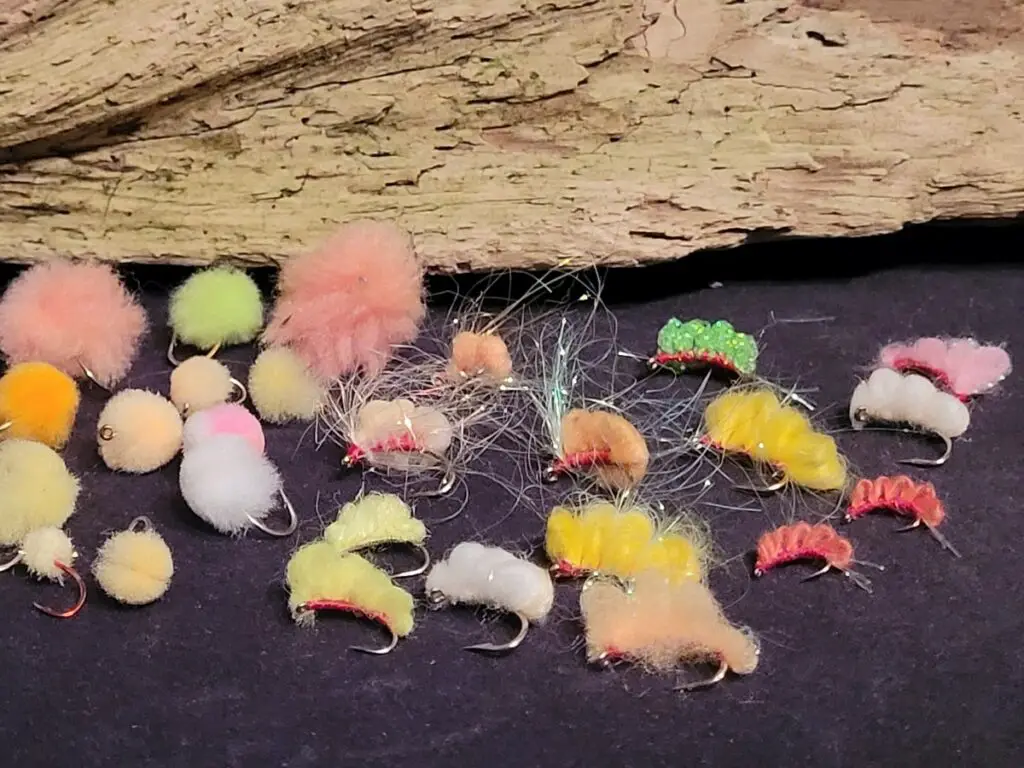
Fancy flies that you see online and in books do catch steelhead, but I have found it’s often best to stick to proven flies and not waste too much time looking for that “magic fly” that’s going to catch all the fish for you, because it doesn’t exist.
If fancy flies worked so well, you would see them in the fly boxes of guides, but that’s not what I see when I look in the boxes of guides. The flies inside the boxes of guides are as close to the “magic fly” as you’re going to get.
5 Essential Steelhead Flies For Nymphing
| Fly Pattern | Description | Best Colors | Size Range | Key Features |
|---|---|---|---|---|
| Yarn Egg | Highly productive egg pattern | Peach, Salmon, White, etc. | Varies | Great for imitating salmon eggs |
| Worm Pattern | Effective steelhead fly | Pink, Brown, Red, Purple | 3-5 inches | Tied with hook at the end |
| Stonefly | Effective nymph pattern | Black, Brown | 6-14 | Good for nymphing rivers |
| Woolly Bugger | Classic steelhead fly with marabou tail | Black, Olive, White, etc. | 1-3.5 inches | Versatile and effective |
| Hoh Bo Spey | Spey-style steelhead fly | Assorted | Varies | Great for swinging in currents |
Pro Tip: If you can imitate their natural food sources more precisely or find flies that trigger a strike response, you will increase your chances of getting them to bite more consistently.
So let’s find out which flies the guides use.
1. The Egg Fly – All-Time Best Fly For Steelhead
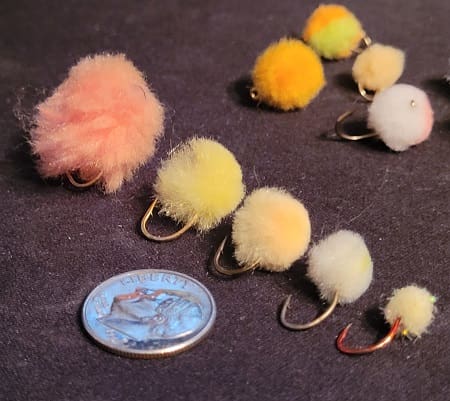
Egg flies probably catch more steelhead than any other fly patterns, and they work everywhere. For this reason, you will see egg patterns in almost every steelhead guide’s box.
But there are dozens of different egg fly patterns. Some are good, and some not-so-good.
If you take a lesson from the Centerpin and float fishing guys that crush steelhead on beads, and based on my experience, the number one egg fly pattern is the basic Glo Bug Egg Fly. It’s round, it looks like a single egg that steelhead feed on readily, and it’s easy to tie or buy.
This is a pattern you will find in most guide fly boxes.
You may hear it called the Yarn Egg, McFly Egg, or the Blood Dot Egg. Whatever it”s called, it’s a go-to fly anywhere in the world for any fly fishing guide who nymphs for steelhead.
My best colors are:
Steelhead Egg Fly Colors and Sizes
| Bait Color | Water Condition | West Coast Hook Size | Great Lakes Hook Size |
|---|---|---|---|
| Peach | Clear water | 6 to 8 | 8 to 10 |
| Salmon | Clear water | 6 to 8 | 8 to 10 |
| White | Clear water, Winter | 6 to 8 | 8 to 10 |
| Light Pink | Clear water | 6 to 8 | 8 to 10 |
| Chartreuse | Dirty water | 2 to 4 | 4 to 6 |
| Hot Pink | Off-colored water | 2 to 8 | 4 to 10 |
| Orange | All water conditions | 6 to 8 | 8 to 10 |
| Yellow/Cheese | All water conditions | 2 to 8 | 4 to 10 |
There are times when egg flies with some flash like the Crystal Meth or Estaz Egg will work better. In dirty or off-colored water, these flashy eggs can be great choices. Some of the best egg fly patterns are:
- Blood Dot Fly
- Otters Soft Milking Egg
- Crystal Meth Egg
- Estaz Egg
- Nuke Egg
- Micro Spawn Fly
- Sucker Spawn
- Death Roe Bead
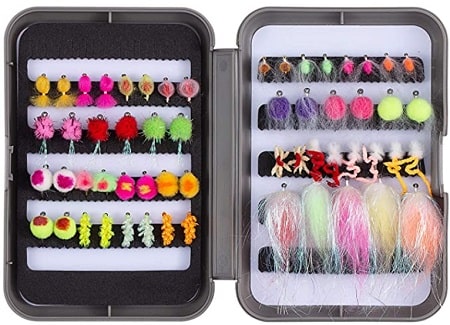
For anglers looking for a great mixed pack of eggs, check out the BASSDASH Trout Steelhead Salmon Fishing Flies Assortment from Amazon.
See more at Best Egg Patterns For Steelhead.
2. The Worm Fly – The Best Fly For Steelhead
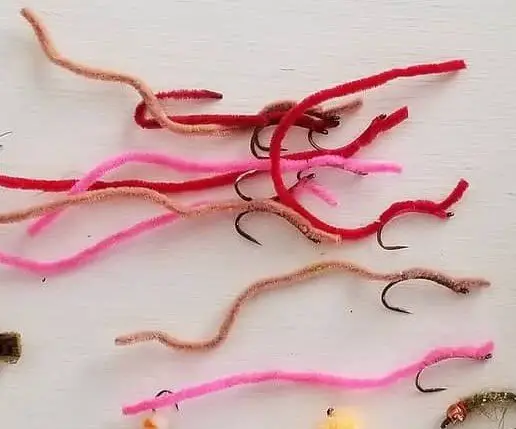
The Steelhead Worm pattern is by far my most productive steelhead for Great Lakes steelhead on all rivers, all year long, and in most water conditions.
Something about a big bright worm presented well is hard for most steelhead to resist.
3 to 5 inches works, with 3.5 to 4 inches is best.
Pink is my most effective color, but red and brown have also been very effective. I have also done well with a light purple color.
For more information, see “Best Worm Flies For Steelhead.”
3. The Stonefly: One Of The Best Fly Patterns For Steelhead
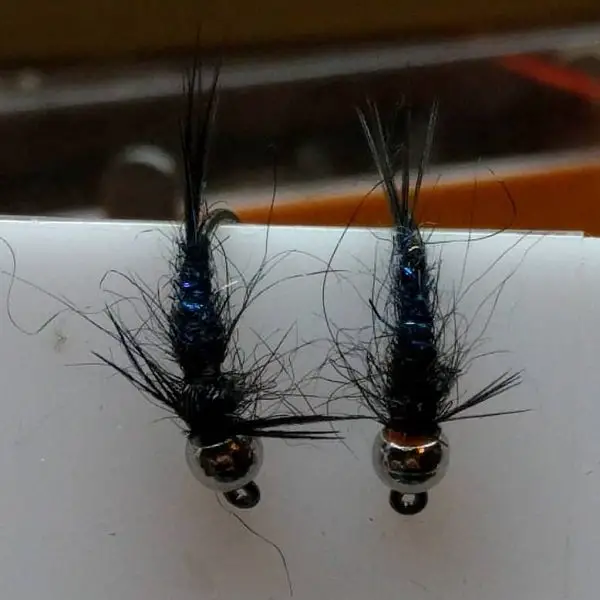
The Stonefly Nymph is one of my favorite steelhead flies. Whether it’s tied in black or brown, yellow, or tan, this is a great steelhead fly you can use for nymphing rivers that have a substantial nymph population.
Nymphs like stoneflies are often more effective for summer-run steelhead and late-spring steelhead than egg patterns.
Size 6 to 12 is best for steelhead, just make sure you use suitable hooks that won’t bend or break on big steelhead.
Some of my favorite Steelhead Fly Patterns include:
The Simple Black Stonely: I tie mine with black dubbing instead of nymph skin and use gold, silver, and blue wire ribbing. See it Here
- Rubber Leds Stonefly – Rubber legs stonefly patterns are favorites of many anglers and guides. The legs give movement and life to the fly. Some of my favorites are the Rubber Leg Stonefly Variant, and the Rubber Leg Kaufmann’s Stone.
- The 20 Incher Stonefly Nymph – See it Here
- Agent Orange Fly – Sometimes, stonefly patterns with colored bead heads can be very effective, but this is usually my last choice. See it Here
- Pheasant Tail Nymph: Although it’s considered a mayfly nymph, it also closely resembles a stonefly nymph, and it is a great fly for steelhead.

4. Woolly Buggers: A Great Fly For Steelhead
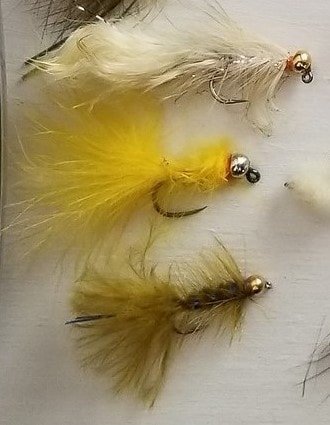
Woolly Buggers and variations are one of those flies that just seem to catch steelhead everywhere, and they are consistent producers.
The thing with Woolly Buggers is they can be fished very small, under an inch long, and look like a nymph such as a stonefly or hex nymph, or they can be tied 4 or 5 inches long and swung across the river or stripped in.
The other great thing with a Wooly Bugger is you can use black, brown, or olive, which works great in clear water, or you can try bright Chartreuse, pink, or white in off-colored water. Add some flash, and it’s a deadly fly for steelhead.
5. Hares Ear Nymph and Variations
The Hare’s Ear Nymph and its variations are deadly for steelhead on many rivers, and at times, it’s hard to beat. The original version is the Gold Ribbed Hares Ear nymph tied in a tan color. But I tie this original pattern in black, brown, and original tan or natural hare’s ear color.
I also tie mine with and without beads. The original calls for a gold bead, but silver, copper, and black can be excellent.
With or without a bead head or ribbing, these are four variations you should have in your fly box:
- Bead Head Hare’s Ear Nymph
- Flashback Hare’s Ear Nymph
- Bead Head Walts Worm
- Sexy Walts Worm
You will see Hares Ear Nymphs In many guide boxes.
6. The Prince Nymph and Other Attractor Nymphs For Steelhead

The Prince nymph is an effective attractor nymph fly that I consider a great fly for steelhead.
The prince nymph is one of my more productive nymphs in late spring or when the steelhead are being pressured by roa bag anglers. Sizes 6 to 10 are best.
Euro Nymphs For Steelhead
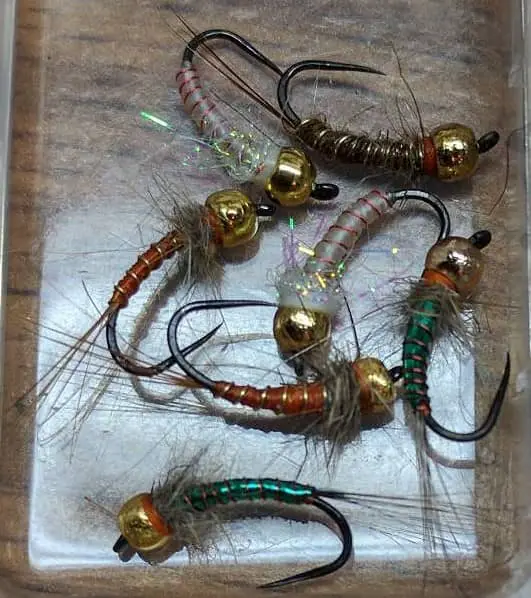
I tie a lot of other attractor-type Euro Nymph flies that work great for me. I call them attractor flies because they are not close imitations of nymphs.
Instead, they are skinny, weighted nymph flies, often with some added color built-in like orange, pink, red, or chartreuse colors or tails.
7. Frenchie Fly Pattern
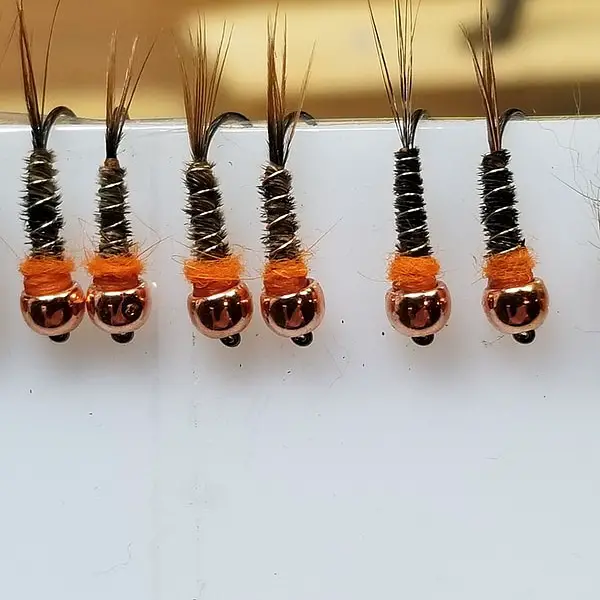
The Frenchie is one of my most effective steelhead fly patterns and one of the easiest flies to tie.
The Frenchie Fly taught me a valuable lesson, which is that basic flies (no legs, no wingcase) that get deep catch a lot of fish. In fact, many of my clients and buddies tell me it’s their best-producing fly.
8. Rainbow Warrior
Sometimes bright and shiny is what the steelhead wants, and one of the best attractor flies is one called the Rainbow Warrior.
With the heavy tungsten bead, it gets deep into the strike zone, and the flash gets their attention.
9. Copper Johns
At times, attractor flies like the Copper John and the Copper Bob can be very effective. You will see this fly in the boxes of steelhead guides.
Bonus Fly – The BlowTorch Fly And Tag Flies
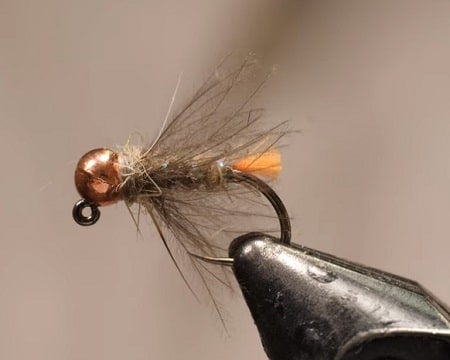
One of my most effective steelhead nymph flies over the last few years is the Blow Torch fly with an orange-tagged tail. I’ve tied this with an orange, pink, chartreuse, and light purple tag (tail), and all are good.
This is worth trying anywhere you fish.
Tag nymphs are a new thing brought on by European and other competition anglers.
With Tag flies, instead of hair or feathers as the tail, they use colored yarn or similar colored material for a short tail.
10. Squirmy Wormy Worm Fly
The Squirmy Wormy and its variations such as the Squirmy Wormy Jig fly are great for steelhead. The rubber material provides good movement and action in the water that really gets the steelheads attention.
3 to 5 inches is good, with 3.5″ to 4 inches being the best size.
The best colors are pink, red, and brown. Some anglers also do well with chartreuse, orange, and purple.
Streamers For Steelhead
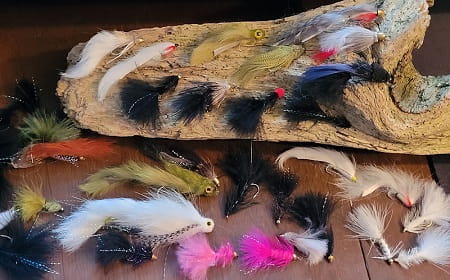
Streamers can be very effective for steelhead. With smaller streamer flies, you can nymph them under an indicator or dead drift them using the Euro Nymphing method.
Streamer can also be stripped in. I use 3 to 5-inch streamers when streamer fishing.
Streamers can also be cast across the river and swung through the current.
To learn more on how to set up your streamer and the best streamer flies, see Streamer Fishing For Steelhead.
11. Egg Sucking Leech
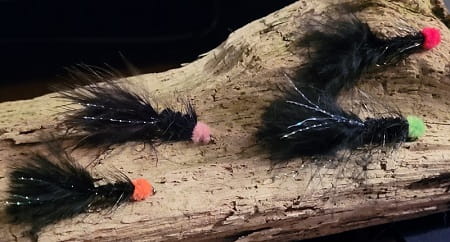
Similar to a woolly bugger is the egg-sucking leech and the Woolly Worm and both can be excellent for catching steelhead. Black, olive, and white are my favorites.
12. The Wooly Worm
The Wooly Worm is basically a Woolly Bugger without a tail. This specific fly is basically a yarn body with a soft saddle hackle wrapped around it. I have been catching steelhead on this fly for over 30 years.
13. Zonker Fly For Steelhead
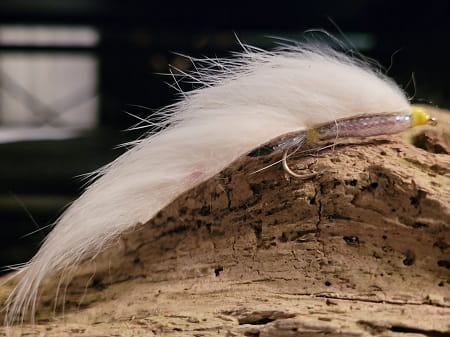
I have found that on some rivers, white streamer flies like a white zonker or a white wooly bugger can be very effective on steelhead because they imitate shinners.
Stripped in, Euro nymphed, or fishing under an indicator can be excellent.
Check out this episode of The New Fly Fish Show as top Great Lakes steelhead guide Jeff Blood explains how and why to fish white zonkers for Great Lakes steelhead.
Other Great Patterns For Steelhead
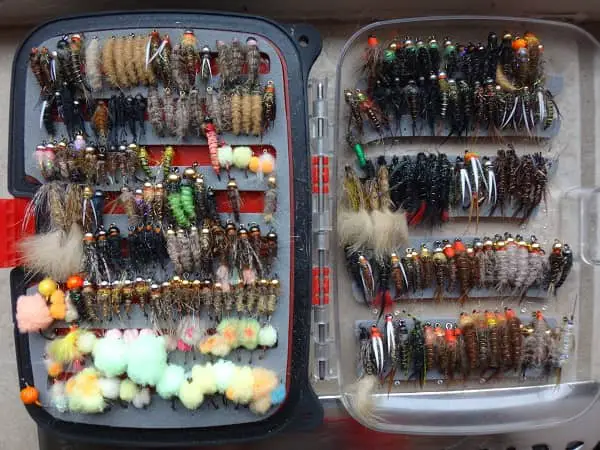
Other great nymphs for steelhead include:
- Michigan Wiggler – Brown, white, yellow, orange, pink, and black
- Green Butt Skunk – This fly has been shown in many steelhead books, and although not my favorite, it is worth a try.
Spey Patterns and Swinging Flies
Swinging flies for steelhead often requires a specific pattern or two. Most Spey flies are big flies and they use marabou, rabbit fur, and soft feathers. In my opinion, all you need is a large profile with good movement.
Although there are a lot of very cool spey flies that work for steelhead, I bet I bet I could have two spey fly patterns and catch fish consistently anywhere.
14. Hoh Bo Spey Fly
The Hoh Bo Spey fly is a top spey fly pattern for steelhead that you will find in the fly boxes of many Pacific Northwest fly anglers. You will also see spey anglers around the Great Lakes Region using this fly.
It is often the first fly I’ll put on, and most days, you won’t need another fly. I think this fly will catch fish consistently anywhere you fish steelhead.
The reason I believe it is one of the best fly for steelhead is because it has a good profile and movement that imitates swimming baitfish. It can be tied small or large, and it can be tied in every color you can think of.
You can also tie it in one color or two-tone.
15. Pick Yer Pocket Fly
A spey fly that can be tied in many colors. It has great movement in the water and is a good steelhead fly.
16. Fish Taco Fly
Similar to the Pick Yer Pocket fly is the Fish Taco Fly, which is another great fly that gives off a lot of movement in the water when swung.
17. The Intruder Fly
The Intruder is likely the most popular steelhead fly for Spey fishing and is one of the best spey flies on the planet.
It can be tied in many different colors and sizes for different water conditions.
The only reason I like the Hobo Spey better is because it’s easier to tie.
Winter Flies
When fishing for steelhead in the winter and early spring in icy cold water, my three favorite flies are the ones I’ve mentioned above which are:
- White glo bug egg
- Black stonefly nymphs
- San Juan worms
See all my favorites at Best Winter Steelhead Patterns
BeadHead, or No BeadHead?
Beads attract steelhead in most river conditions, and for that reason, you will see a lot of bead head nymphs in the boxes of anglers and guides. In some guys’ boxes, over 90% of the flies will be beadhead flies.
However, under certain conditions, such as gin clear water and when the steelhead are nervous, I have seen steelhead avoid bead head flies, which is why I always have some non-bead head flies or flies with less intrusive black flies.
Other Recommended Flies From Other Websites
These are flies that are recommended on other websites.
I have tested these out, and they are not consistently effective for me, but they might work well on your steelhead rivers.
- Steelhead Bomber – It’s a great fly when the conditions are perfect for steelhead to hit a fly on the surface. It can be perfect for summer steelhead.
- Skagit Minnow – A good fly to swing
- Polar Shrimp – Another almost classic used to swing.
- Bears Hex Nymphs – In some parts of the country, like Michigan, this can be a good fly pattern.
Now that you have an idea of what flies to use, do yourself a favor and be sure you are using one of my proven Steelhead Leader setups.
FYI, I spin fish and float fish with flies, and it is very effective if you know How To Fish Flies With Spinning Gear, which I’ll explain if you click the link.
If you have a question or comment or want to share some of your best fly patterns for Steelhead, let me know in the comments section below.
Tight Lines
Graham

Hi Graham. What is the line length under the first swivel based on your basic float fishing set up diagram?
Hey Rocco, The length of the bottom of the leader will depend on the water clarity. In very clear water I may go 20 to 24″ and in dirty water, I may only use 10″ inches. There is an updated float leader setup on the Best Leaders For Steelhead page
Hi Graham,
I find that the rivers i tend to fish don’t have very deep pools, thus I usually run a leader which is a Max 18-24”. But then I could hit a spot where the pool is a little deeper, and when I pull my float higher , my coloured mainline is now submerged. Could that be spooking fish?
By the way…..I’m planning on booking a day in the spring for steelhead, and I saw that you don’t offer a 4 hour walking steelhead guided trip/lesson. Why not?
Best regards,
Lorenzo
Hi Lorenzo,
Yes, your mainline could spook the fish if it’s too close to the fish, but if you use a proper leader setup it should not be an issue. There is an updated float leader setup picture on the Best Leaders For Steelhead page. If you use this leader set up with a clear fluorocarbon shot-line then your mainline will always be far enough away from the fish that they should not see the mainline regardless of how much mainline you submerge into the water. Also, check out my other leader set-ups and the best angles and other tips on the Centerpin For Beginners page. For questions regarding guiding services it’s best to always email me through my guide website A Perfect Drift Guide Company. See you in the spring.
Hi Graham,
I am wondering what fly you were catching steelhead on with Bill Spicer. At the end of the episode you were fighting a steelhead and when dragging it into the net I could see a large pink egg. Would like to know what material this fly was tied with and a picture of it. Thanks.
Hey Hunter,
That river is always either green or brown and almost never loses its color, and because of that, I have found that the steelhead in that river often like very large egg patterns.
I tie most of my smaller eggs with McFly Foam but when tieing my bigger flies a standard egg yarn is all I use. I will provide a link to how to tie a standard egg fly, however, when you watch the video you can see how low he cuts the yarn. If you want a bigger fly leave it double or triple the length. You will need to tease it out with a brush or I use my bodkin. That is how I make my large nickle and quarter size egg flies. https://www.youtube.com/watch?v=TMC2DdivtPk
Also, Bill showed me a great egg pattern that I still use today, it is called the Jeff Blood blood dot fly. https://www.youtube.com/watch?v=3lRb8eYVhDo
I hope that helps.
Good luck,
Graham
Hi Graham
Im interested in a guided float trip on the Saugeen for Rainbows , Steelhead with my brother.
Is there availability for before the opener in April or is it better after the opener?
Regards
Les
Hi Les,
I won’t be guiding the Saugeen this year, If you want to float fish or spin fish contact Jordan at A Perfect Drift Guide Company or Matt at Smooth River Guide Service. If you want to fly fish, contact Grand River Troutfitters, or Grindstone Angling.
Good Luck,
Graham
Excellent material for the beginners as well as professional anglers! I would like to ask Grant, if you are attaching your float on the main line with swivel underneath on the shot line or at top???? I see by your diagram it looks like you attach the float on main line???? Thank you! When are you coming out with a video or book!!!!! Excellent information.
Thanks Michael,
I always attach the float to the mainline, above the swivel. Occasionally, if I get into very shallow water, I will remove the float caps slide them over the swivel and reattach the float below the swivel to be able to fish the shallow water. But, that is rare.
I’m currently filming content for YouTube now and hope to have it live in the spring.
Tight Lines,
Graham